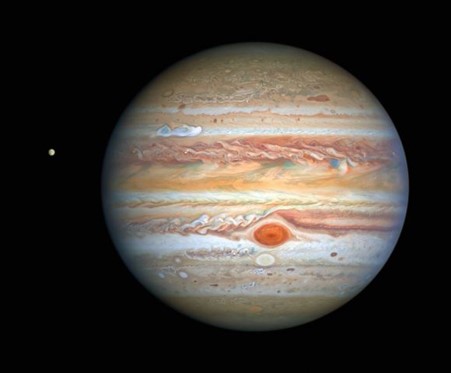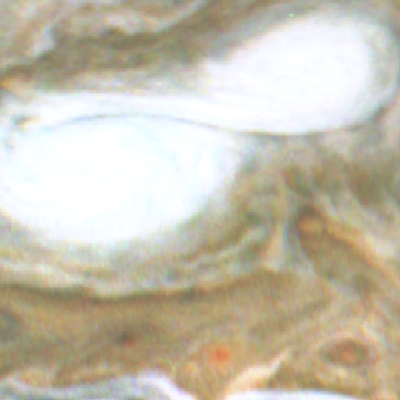As Montessori teacher for the 6 -12 years old, I love to explore what’s Maria Montessori called « cosmic education », a way to inspire and encourage children in learning by inviting them to explore the entire Universe ( planets, plants, animals, the ancient civilizations…).
Exploring astronomy is not only a question of science but a vital answer to the children needs of orientation in time and space. Then all academics discipline (geography, history, writing, mathematics …) are presented in relationship. Stories and discoveries turn lessons into memorable experience for children as they become intellectual explorers.
Two weeks ago, my eyes caught an an article in the « Ouest-France » newspaper about the Jovian Vortex Hunter.
This original recruitment appealed to me. Indeed, among all the planets, the one which always fascinated me is Jupiter with its famous Great Red Spot.
The purpose is to help spotting vortices among thousands of images captured by JunoCam in order to help scientists understand the fluid dynamics and cloud chemistry so they gan gain deeper knowledge of Jupiter’s atmosphere, of the origin of our solar system but also understanding about giant exoplanets .

One night , two weeks ago, I decided to register on the Zooniverse platform for the Jovian VortexHunter project and … start hunting vortices !
The project is ambitious but the research team made easy to classify images depending on some clouds features of what we see on images : (vortex : one or more , turbulent zone, band clouds…).
Even it is a scientific research, I should say it could be like classifying beautiful paintings as images from JunoCam are fascinating and some look like famous masterpieces.





Amoung the « subjects » to classify, a beautiful big red vortex : the Great Red Spot !
I was alone in my kitchen (everyone at home was sleeping) with this amazing discovery.
Can you imagine, the picture has been taken by Juno, flying over the Great Red Spot at about 600 millions miles from Earth
and arrive in my kitchen !
I was so surprised of such reality but the more exciting is the possibility to exchange with the communitiy of vortex hunters and to discuss with the researcher Ramanakumar Sankar.
Thus, I decide, to know much more about Juno.

JunoCam, the «Citizen Science » camera
Juno spacecraft began on 5 August 2011 and arrived at its destination, Jupiter’s orbit, On 4 July 2016 from Cap Canaveral.
I discovered that Junocam was designed and included on the spacecraft for purpose of public engagement.
Indeed, everyone, from anywhere, can participate in this space mission.
You can share observations, exchange information on subjects .
Infinity shape merger
I learned more about the « string of pearls » on Jupiter, the white ovals that appear in the southern atmosphere.
Among the different images captured by Junocam, I had to classify different images with the same amazing vortex in shape of the infinity symbol.

This raw image includes something remarkable : two oval storms caught in the act og merging.
Lucky find as Juno does an elliptical orbit round Jupiter within 53 days .
Most of the time, the spacecraft flies in the dark far away from the planet and flies from the north to the south pole ( which is called a « perijove pass ») in just two hours
The timing with this amazing merger was perfect !!
Oval BA
Here is another point of interest : Oval BA for Oval Bright Anormality
Oval BA is the second largest anticyclonic in Jupiter’s atmosphere after the Great Red Spot.
I’ve never heard about it before (as many books emphasize most of the time the Great Read Spot).
This interesting vortex is at a latitude at about 30 degrees south ( just slightly below the Great Red Spot)

Become a Nasa citizen scientist
A citizen scientist is someone, with or without a scientific education or background holds a genuine interest in the world.
Nasa citizen projects are open to everyone around the world, not limited to the US citizen or residents. Project with the icon can be done by anyone, anywhere with just a cellphone or laptop.
I can’t believe I helped a Nasa mission with already 16381 classifications.
My enthusiasm is not only about sharing ideas with experts and feeling the belonging to the Jovian Vortex Hunter community but sharing passion with others teachers and discoveries with the ones of your life !
More information about NASA citizen science can be found at : https://science.nasa.gov/citizenscience and https://www.nasa.gov/solve/opportunities/citizenscience.
More information about Juno found at : https://www.nasa.gov/juno and https://missionjuno.swri.edu.
Vanessa Toinet—France
Montessori teacher and author / Collaborator- Morvan Céleste
NASA scientist citizen
No responses yet